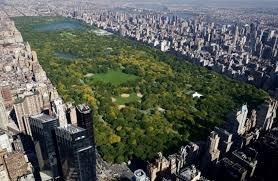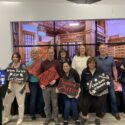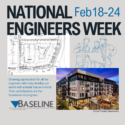Planning Story of the Day
“When I worked for the City of Janesville, one of my tasks was to develop a parks and trails map. It was rewarding to create something that the public used to learn about the great and abundant public amenities available to them – to help them get outside and be healthier and happier.” — Julie Esterl, Associate Planner

Did You Know…? Frederick Law Olmstead is the Founder of Landscape Architecture.
 Frederick Law Olmsted has been called the father of landscape architecture. He actually helped to coin the term, Landscape Architect. His career took off when he paired with Calvert Vaux, an experienced architect, to enter the competition to redesign Manhattan’s Central Park. They won and transformed the park into what we see today – elements of English ramble with a more formal geometric French landscaping. He and Vaux completed many other parks including Prospect Park in Brooklyn and Chicago Riverside Park. After they dissolved their partnership, Olmsted went on to be a huge influence in the visual character of the American suburb, pioneering street setbacks, gaps between houses, and curving streets that followed the topography.
Frederick Law Olmsted has been called the father of landscape architecture. He actually helped to coin the term, Landscape Architect. His career took off when he paired with Calvert Vaux, an experienced architect, to enter the competition to redesign Manhattan’s Central Park. They won and transformed the park into what we see today – elements of English ramble with a more formal geometric French landscaping. He and Vaux completed many other parks including Prospect Park in Brooklyn and Chicago Riverside Park. After they dissolved their partnership, Olmsted went on to be a huge influence in the visual character of the American suburb, pioneering street setbacks, gaps between houses, and curving streets that followed the topography.
What Makes Community Planning Important?
Community planning is much-needed discipline in today’s world when cities are becoming overpopulated and the resources scarce. Its purpose is to find solutions for the use of land and public domains, environmental protection, infrastructure, supply network, and many other segments that make a city functional and operational. Not only are cities constantly in flux in size, but they are usually the greatest polluters in the area. With growth, climate change, and environmental events like hurricanes and storms, community planning became one of the most important fields in creating safe and efficient settlements.
In ancient Rome when the city had nearly one million inhabitants, the importance of community planning was quickly recognized as a perfect measure for various problems in other cities. Population living in urban settlements from 2% of the global population in the 1800s has grown to 51.3% in 2010 according to the data from the United Nations. Community planning is also the discipline which will help build cities on the moon or Mars when terraforming eventually starts, and all other settlements whether in space or other planetary systems.
But why is community planning so important for the big cities and what exactly does it do to shape up the better and environmentally friendlier world?
- Helps cities to grow – with jobs and education, cities grow, which is why a developed framework is important. The framework anticipates all the possible needs of the citizens, appropriate infrastructure expansion and contingencies for emergencies.
- Anticipates disasters – environmental or weather events and terrorism have created serious and dangerous problems. Anticipating these events has become a priority in many cities and all possible scenarios are used to create long-term strategies for reaction, managing risks and creating the best possible outcomes for all.
- Improves quality of life – employment, education, and housing are all major issues for people. Policies and regulations are in place to regulate land use, public spaces, and arrangement of infrastructure, including roads are regularly upgraded and maintained.
- Has a positive impact on the economy – as cities grow, so does the economic requirements. Finances is a main item in community planning and if not planned correctly, it can have a devastating impact on the economy. Issues such as lack of housing or lack of employment can lead to loss of population and the ongoing growth of a community.
- Provides healthy and safe conditions for its citizens – community planning includes public spaces like parks and gardens to create better environmental and recreational areas for people to exercise and spend their leisure time, while also keeping these areas clean and safe.
Community planning is important all throughout the world. Sewer, clean water, electricity, homes, and roads should be available to everyone. These are the fundamentals of infrastructure and planning. Challenges and unpredictable situations can be faced with good community planning. Identifying issues and knowing how to implement improvements and changes to the plans make for a better tomorrow. This week we celebrate our community planners and reflect upon their experience as planners through our “Survey the Planners.” Check out what our planners had to say each day this week for their responses.
- What led or inspired you to become a planner?
“I began studying political science and landscape architecture. Urban Planning is a happy medium between policy and design. I’ve always been curious about how the built environment impacts the way we live our lives.” — Melanie Nieske, Planning Technician
“I got my degree in Horticulture and was interested in Landscape Architecture. Out of college, I got a job with a landscaper, then a private land developer, and then with a City planning department assisting with mapping. Landscape drawings and AutoCAD/GIS mapping use similar skills and while I made maps, I also grew my knowledge of planning.” — Julie Esterl, Associate Planner
“The design field.” — Jessie Stonberg, Associate Planner
“It all boils down to me always having a love of maps and the way the world is laid out, both naturally and in the build environment. We planners are just playing a big game of SimCity.” — Ethan Watel, AICP, Planning Manager
“I started in electrical engineering in college and it hated me – so I found a new curriculum and career that seemed way more fun and creative!” — Vince Harris, AICP, Director of Planning
“I decided to be an architect in the 6th grade. Where I went to school, architecture and urban planning were combined in the same department. I took a planning class in my last undergraduate semester and it inspired me to continue my studies in both architecture and planning.” — Ben Thurston, AICP, Senior Planner
“Discouraged by the services and amenities in my neighborhood growing up, I wanted to create a career as an agent of change. In college, I learned about how city planners of the past had intentionally designed cities to disenfranchise certain groups in certain neighborhoods. I wanted to be involved with changing that history and adding value to the lives of people in underserved areas as well as promote sustainability and social equity.” — Andrew Baker, Associate Planner



